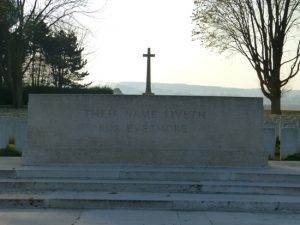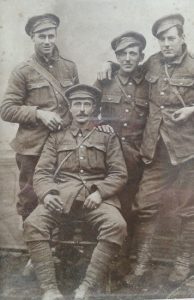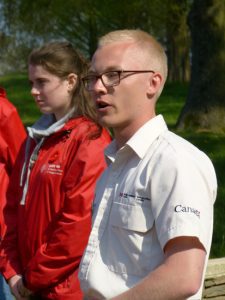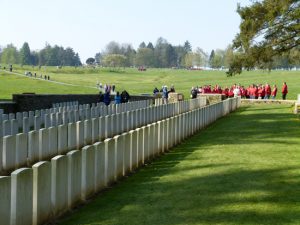
We arrived in the late afternoon. Shadows from an encircling grove of trees cast eerie slivers of light and dark across the manicured cemetery grounds – the grass cropped short, the flowers freshly tended. I watched one of my fellow travellers, Valerie Flanagan, move from one line of tombstones to the next. Our walk through La Chaudiere Military Cemetery just below the famous Vimy Ridge, a few days ago, was the culmination of a long journey for her. Then, she saw it – her grandfather’s grave.
“I’m so glad I made it here,” she said. “I didn’t know how I’d feel.”

The story of Private Sidney Cox of the 46th Battalion of the Canadian Infantry rings true for so many families affected by the Great War. But his wasn’t written in a history book. It was written in Valerie Flanagan’s face. It told of a man born in England in 1885, of his marriage and of his beginning to raise four children. Prospects seemed greater in Canada, so Cox answered a call to work in the wheat fields of Saskatchewan, in hopes he could later bring his family along behind him. The Great War intervened. He joined the 46th Battalion in Moose Jaw, Sask., and was shipped back to England before embarkation to the Western Front in August 1916.
“He maybe saw his young family twice,” his granddaughter said.
During active service Cox’s battalion served at the battles of the Somme, Ancre Heights and Vimy Ridge. So decimated was the 46th – losses in the ranks of nearly 92 per cent – that his regiment became known as “the suicide battalion.” As the front-line forces of the Canadian Expeditionary Force captured the first trenches atop Vimy Ridge, Cox brought forward supplies of gas canisters and other supplies behind the lines. But he didn’t savour the victory at Vimy long; Cox was felled by a sniper on May 5, 1917. He was just 31.

“It has always been my dream to visit his grave,” Valerie Flanagan wrote me months ago, “to honour him and my grandmother.”
As Valerie and I stood for photos at Sid Cox’s grave, other evidence of this “lost generation” crossed my mind. Just a few days before, I had stood near the famous Danger Tree, in the middle of the Beaumont-Hamel battlefield.
On the morning of July 1, 1916, about 800 members of the Newfoundland Regiment had advanced down a slope toward an enemy that was deeply entrenched and heavily armed. Their machine-gun and artillery fire so decimated the Newfoundlanders’ ranks that fewer than 70 men answered the roll call the following morning. Among those lost were W. White, S. Jeffers and M.J. Holland, all buried in the Y Ravine Cemetery at one end of the battlefield.
And there at the entrance of the cemetery stood a young Parks Canada guide named Kaleb Perry, telling their stories. All three – White at age 26, Jeffers at age 23, and White only 19, had died in the virtual massacre, Perry told a group of students from Owen Sound; the teenage students didn’t move a muscle as Perry described the hail of fire the young Newfoundlanders attempted to dash through.

“On their grave the epitaph reads, ‘Gone but not forgotten,’” Perry recited. But he wasn’t finished. He called on the students to make a personal commitment.
“It’s up to you to remember. It’s up to you to carry the torch. It’s up to you to keep their stories from being forgotten,” Perry said.
And I remembered a story I’d found years ago about “the lost generation” and the Great War. It was the memoir of small-town kid named Harry Loosmore. As a soldier in the Canadian army, he’d witnessed gas attacks, participated in full frontal attacks, and at 24 was an expert horse-shoeing smith.
From his post with the 31st Battery at Vimy, he tended artillery-hauling horses, watched groups of German prisoners parade through Canadian lines, and scanned incoming stretchers. He lamented in his diary about friends lost in war, but also about the impact their deaths would have on his home community back in British Columbia.

“Salt Spring Island paid a high price for her share in the war,” Loosmore had written. “The two Lumley brothers of Fulford were killed by the same shell. Henry Emerson, who operated Mouat’s Feed Store, went too – I can still see him practising ball catching with Arthur Drake on Ganges Wharf in the summer of 1915. Donald Craig, age 20 … and Charlie Dean … who acted like a big brother to me … died of wounds and was buried in Barlin extension cemetery.”
Losing a grandfather, three-quarters of a regiment, or the guy who taught you how to catch a baseball to the Great War, all had greater impact than mere mortality statistics in a history book. The deaths of those young men had left gashes in hearts and holes in community life – the true cost of a senseless war.
Thanks so much, Ted. This trip meant so much to me! I learned so much history that I never took in high school classes. My grandmother lived with us and neither she nor my dad ever talked about the war or their experiences or their feelings, either. It must have been very hard for them. Thanks again.
Thanks Ted for telling the stories of these families. It gives those of us at home a glimpse into the impact the trips and commemorations meant to all those Canadians who were able to travel to France. It has been a very memorable month.